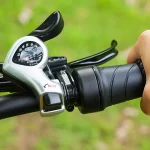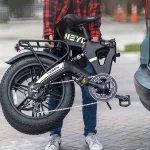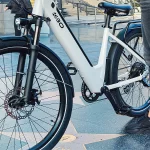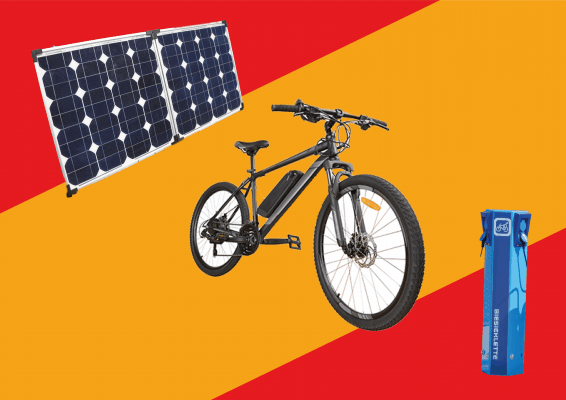
Knowing electric bike batteries have a limited charge can give you range anxiety. This can reduce the fun and sense of freedom you get from riding electric bikes. You may even avoid making certain longer cycle trips due to range anxiety. Furthermore, you may not take your electric bike with you on weekends away like camping trips, if you feel you’ll have nowhere to recharge it. However, what if there were ways that you could charge your electric bike away from your home? Would this mean you’ll go on longer cycle rides and take your electric bike with you away on cycling trips?
When it comes to electric bikes, there are certain ways you can in fact charge your battery on the go. These include taking a charger with you, say in a backpack or pannier for example. You can then use it to charge your battery at stop offs, like in a cafe or a pub. Increasingly, dedicated electric bike charging points are appearing at various places. There are even ways that are particularly suitable for charging your electric bike battery on trips away. These include through your car battery, solar panels, or by using a portable power station.
Here, in this article, I talk in detail about these methods of charging your electric bike battery whilst you’re out and about.
Table of Contents
Charging Your Electric Bike at Stop Offs
As mentioned above, it is possible to charge your electric bike at stop offs such as cafes and pubs. This requires an element of planning though, if you’re intending on charging at a stop off mid cycle. Below are some pointers to help you do just that.
- Check the cycle route in advance to see if there are any suitable stop offs.
- Make sure potential stop offs appear at a point within the route, before your battery’s likely to run out of charge. Therefore, it’s ideal to have a good idea of your battery range. Bear in mind though that different factors such as riding speed and incline affect range. Therefore, anticipating your electric bike battery range may not always be straightforward. However, this range calculator from Bosch will help you to do just that though.
- You should consider the distance between the stop off and the end of the cycle. If you’re charging at more than one stop off, then consider the distance between each stop off and the distance between the last stop off and the end of the journey. Ultimately, after charging, you need enough range to get you to the next stop off and to the end of the ride.
- It’s ideal to know how long it takes for your battery to charge. You may not necessarily stay at a stop off long enough for your battery to charge fully. However, you want to at least charge your battery enough to get you to the next stop off, or to the end of the journey. So for example, you may arrive at a stop off with 30% battery charge left, needing another 40% charge to get home. If you know it takes 1½ hours to charge 40% of your battery, then you can plan to stay at the stop off for at least 1½ hours.
- It’s no guarantee that a stop off will let you use their electricity to charge your electric bike battery. So never assume a stop off will let you use their electricity. If they don’t let you, then you could end up without electric assistance before the end of your ride. So it’s a good idea to contact planned stop offs in advance, to ask if they’ll let you charge your electric bike battery. Therefore, check your planned route for possible stops offs in advance and get their telephone numbers online.
- This follows from above. A stop off is more likely to let you charge your electric bike battery, if you’re using their service. So if you’re charging at a cafe, have a coffee or 2 and maybe even a slice of cake. Likewise, if you’re charging at a pub, you could have a pub lunch and possibly a pint or 2. In itself, it’s common courtesy to spend money at the stop off if they’re letting you charge your battery. Besides, you’ll enjoy the stop off more if you’re stopping for a pint or a coffee. You can even plan your cycle journey so that you arrive at a pub at lunchtime.
- You can even take advantage of overnight stop offs to charge your electric bike. These can include hotels, hostels and campsites.
- Most importantly, don’t forget to take your electric bike charger with you. You can use a backpack or pannier to carry it.
Charging Your Electric Bike From Solar Panels
You can use a solar panel as a way of charging your electric bike battery. This lends itself more for if you’re away on a trip for the weekend, or a few days. The reason being because solar panels aren’t portable enough to take on your electric bike. So you would typically use a solar panel to recharge your battery when you’re back at base. You could take a foldable solar panel with you in the bucket of a cargo bike though. These types of solar panels are very light, usually under 10 pounds.
The great thing about using a solar panel to charge your battery is that it gives you total freedom. It removes the need of you having to be near any electric power outlets.
A Charge Controller is Needed
When using a solar panel, your electric bike battery is not charged directly from the panel itself. You will need a charge controller connected between the solar panel and your battery. These charge controllers regulate the voltage and amperage coming from the solar panel to your battery. This is what allows the battery to charge up from the power coming from the solar panel.
Charge controllers are needed to regulate solar panel’s power output because not all electric bike batteries are equal. This is due to the fact that these batteries have varying voltages and amperages. So, when using a charge controller, you’ll need to manually adjust the voltage and amperage output to match your electric bike battery. Your battery will be damaged if the voltage and amperage coming from the solar panel/charge controller is more than your batteries. Victron makes a very good range of charge controllers. With these, you adjust the settings through an app on your smartphone. Your smartphone interacts with this Victron charge controller through Bluetooth.
Connections
To connect the solar panels to the charge controller you need a pair of solar connector cables. Solar panels will have a pair of cables coming from them. One of these cables is the positive connection and the other cable is the negative. These cables coming for the solar panel will typically have MC4 connectors on the end. You then have the solar connector cables connected between these cables coming from the solar panel and the charge controller.
The solar connector cables are a solar PV wire, with an MC4 connector on one end and stripped on the other. The end with the MC4 connector, connects to the MC4 connector at the end of the cable coming from the solar panel. The stripped end connects to a PV terminal on the charge controller. There are 2 PV terminals on the charge controller. Again one’s a positive connection and the other’s a negative.
The idea is that the positive cable coming from the solar panel is connected to the positive PV connection on the charge controller, via a solar connector cable. This is likewise with the negative solar cable and the negative PV connection. These PV connectors are often labeled as solar, or with a picture of a solar panel.
You may need to make a custom lead, that takes the power from the charge controller, to your electric bike battery. A demonstration of how you can do this is included within this video. This lead would need to come from the battery output of the charge controller, by the way. Also the below articles both have helpful information with regard to creating one of these leads.
“3 Ways to Solar Charge and Electric Bike”
“How to connect a Solar Panel to a Battery”
Get as Much Sun on the Solar Panel as Possible
The more sun that hits the solar panel, the more power (in watts) it will put out. The more power (again in watts) the panel puts out, the faster your battery will charge. So the most effective time of day to use a solar panel is midday, when the sun is at its strongest. Therefore, the closer to midday you’re using the solar panel, the faster your battery will charge. You should also position a solar panel so it’s pointing directly at the sun as much as possible. This may even require you to prompt the solar panel up against something, so it’s in a tilted position.
As you may also gather, the sunnier the day is, the more it will maximize the power output of solar panels. So charging from a solar panel will be quicker in the summer months. Furthermore, solar panels have a peak power (in wattage) stated. For example 150 watts, 200 watts etc. However, they will only output this peak power in peak sunlight conditions.
There’s a calculation to determine how long (in hours) it will take your electric bike battery to charge when using a solar panel. You simply divide your battery capacity in watt hours, by the watts coming from the solar panel. The example below shows this calculation for an 800 watt hour battery, if 150 watts is coming from the solar panel.
800wh ÷ 150 watts = 5.33 hours (a little over 5 hours)
Bear in mind that electric bike batteries can take longer to charge from solar panels than from the mains. Again, this depends on how much sun the solar panel is getting.
Using 2 Solar Panels
You can halve the charge time by using 2 solar panels. Using 2 panels increases the wattage passing through to the battery. This in turn reduces the charge time. This article talks about how to use more than 1 solar panel as part of your charging set up.
Charging Your Electric Bike with a Jackery
A Jackery is a portable power station that you can use to charge your electric bike from. You typically charge the Jackery from a mains power supply. It then stores this electric charge, so that you can then plug an electrical appliance into it like a mobile phone or laptop. The Jackery then charges the appliance that you have plugged into it. This is by transferring electricity from itself to the appliance.
The Jackery is ideal for taking away with you on cycling trips to recharge your electric bike battery. Like using solar panels, a Jackery lends itself more to taking with you on cycling trips away for a few days, rather than for single bike rides. The reason being that their weight makes them implausible to take with you on a bike. This is unless you have a cargo electric bike though.
If you’re going away for a cycling weekend, you can put a fully charged Jackery in the van or the boot of your car. You can then use the Jackery to recharge your electric bike battery whilst you’re away. You simply plug your charger into the AC output on the Jackery.
Different Capacity Jackery’s Available
There is a range of different Jackery’s available. Each one of these has different power storage capacities in watt hours. So the amount you can recharge your electric bike battery by, will depend on which Jackery you’re using. The capacity of your electric bike battery will determine this as well.
Charging Time
This video can help give you some idea of how long it takes for a Jackery to charge your electric bike battery. The video shows that for a 500wh battery, it takes the Jackery 1 hour to charge 30% of it. That’s about 1% for every 2 minutes. This is though, when charging from a US mains power socket. So you can use this as a guide to get an idea of how long it would take for a Jackery to charge other capacity electric bike batteries.
Using a Jackery to Charge a Cargo Electric Bike
As mentioned above, you could use a Jackery to charge an electric cargo bike mid ride. This will mean that you won’t need to find a stop off with a charge point.
Even though Jackery’s are quite heavy, they’re still not too heavy to be carried in the bucket of an electric cargo bike. Below shows the weight ranges and capacity in watt hours, of the Jackery’s currently available on the market.
Jackery Explorer 240 – 240wh – 6.6 pounds
Jackery Explorer 300 – 293wh – 7 pounds
Jackery Explorer 500 – 518wh – 13.3 pounds
Jackery Explorer 1000 – 1002wh – 20.04 pounds
As you can see, the heavier the Jackery, the more capacity in watt hours (electric charge) it holds. Even if you have an electric cargo bike with a bucket that can handle carrying the 20.04 pound Jackery, you may not need the capacity it provides. The 13.3 pound Jackery may give you enough capacity for what you need. In which case you can save on weight by not opting for the 20.04 pound one. Not to mention saving on cost as well. If you’re already using the cargo bike to carry other cargo, then you’ll want to save all the weight you can.
Taking a 500wh electric bike battery as an example, the 240wh Jackery can only charge under half of the battery. However, if you need to top up your battery mid cycle to get you home, this may still be enough. The 500wh Jackery can fully charge a 500wh battery though. It can also charge over half of a 700wh or 800wh electric bike battery. Again, this can still be enough to get you to your destination. You probably won’t fully discharge a Jackery anyway if you’re using it to recharge your battery mid ride. However, it’s reassuring if you know it has enough charge to cover you.
A 1002wh Jackery has enough capacity to fully charge a 500wh electric bike battery twice. Therefore you may deem it excessive to take one of these with you on a single electric bike ride. On the other hand though, you won’t need to charge up the Jackery itself so often between rides.
Depending on the battery management system (BMS) of your battery, a Jackery can literally charge your electric cargo bike battery on the go. You may not necessarily have time to recharge your electric bike battery enough during a mid cycle brake. So when your battery is running low, you can then stop to connect your Jackery to your battery. Then you can set off cycling again, so that the Jackery is powering your battery whilst you’re cycling. Remember this depends on if your BMS allows for this though. This can ensure you have enough range to get you home. If you’re doing this though, make sure the charger and lead between the Jackery and the battery is secure. You may find this very tricky to pull off though, especially as chargers are cumbersome.
You may possibly work in deliveries and use an electric bike for this. In which case, taking a Jackery with you can give you the range to see you through the day. You may need to strike a balance between the Jackery not adding too much weight and it giving you enough extra range. Taking a Jackery with you on an electric cargo bike, can even allow you to go on cycle trips with overnight stops.
Using a Jackery with Solar Panels
If you’re away on a cycling trip, then you can use a solar panel to charge a Jackery. You can then charge your electric bike battery from the Jackery afterwards. Here, you don’t use a charge controller (as talked about further above), because Jackery’s have one built-in. Some solar panels, though, do have a charge controller built in. If you do have one of these solar panels, this video shows you how to disconnect the solar charger. This would then make your solar panel compatible with the Jackery.
shows you how to disconnect the solar charger. This would then make your solar panel compatible with the Jackery.
You may be wondering though why would you use a solar panel to charge the Jackery, rather than use a solar panel to directly charge the battery. Well the reason being is that solar panels obviously need the sun to provide power. However, sun is only available during the day, which is when you’ll be cycling. So you may not have enough time during the day to fit in a ride and charge the battery from a solar panel.
So you can charge the Jackery from the solar panel, whilst you’re riding your electric bike. Once you’ve finished your ride, you can then use the Jackery to charge your electric bike battery. This could even be in the evening or overnight, when there’s little or no sunlight. Then you can have a full battery charge the next day. By the way, it’s OK to leave your battery on charge through the Jackery overnight. Once the electric bike battery is full, it will stop charging. So there’s no danger of it overheating, or the Jackery discharging more than necessary.
Jackery’s even have their own solar panels which you can buy separately. To connect a third party solar panel to a Jackery though, you’ll need a solar panel to 8 mm adapter cable
which you can buy separately. To connect a third party solar panel to a Jackery though, you’ll need a solar panel to 8 mm adapter cable . These have MC4 connectors on one end and an 8 mm connection on the other. This cable would then plug into the 8 mm input on the Jackery. You can even connect a pair of solar panels to a Jackery, for it to charge up twice as fast.
. These have MC4 connectors on one end and an 8 mm connection on the other. This cable would then plug into the 8 mm input on the Jackery. You can even connect a pair of solar panels to a Jackery, for it to charge up twice as fast.
Electric Bike Charging Points
Increasingly, more and more dedicated electric bike charging points are appearing. This is as a result of electric bikes becoming more popular. These charging points allow you to charge your electric bike mid ride whilst you take a break.
Plugshare.com allows you to find various electric bike charging points around the world. It’s not dedicated to electric bike charging points only by the way. It covers plug-in points for all sorts, such as caravans and electric cars etc. So you need to filter down to electric bike charging points, by only having wall sockets selected under the filters.
Every time you find an electric bike charging point you can share it yourself on Plugshare.com.
Furthermore, Bosch has now started making electric bike charge points on biking trails. Below is a link to help you find where these Bosch electric bike charge points are located.
Bosch Electric Bike Charge Point Finder
Bike Energy also has a network of electric bike charging stations. To use these charging stations you’ll need a special adapter cable though. You can find out more about these charging stations by going to Bike Energy’s website. You’ll find these charging stations at various public and tourist locations. They can even charge your electric bike battery up to twice as fast. Below, is a link to a map showing the locations of these Bike Energy charge points.
Bike Energy Charging Station Map
Charging Your Electric Bike From a Car Battery
You can charge your electric bike from your car battery. You’ll need a gadget called an inverter to do this though. There’s a couple of other gadgets that you could do with here as well, but aren’t entirely essential. I list these gadgets (as well as the inverter) below.
Inverter – around £70
Battery and alternator tester – can be picked up for around £5
Electricity Usage Monitor – around £15 to £25
Inverter
The inverter converts the DC current from the car battery, to an AC current, required to charge the electric bike battery. Therefore, you charge your electric bike battery from the car battery, via the inverter. You connect the inverter to the car battery using crocodile clip/car battery cables. Although you should use battery cables with a 10 amp fuse on the positive cable. This protects your car battery from possible damage. Damage is more likely if you have a high amp charger and a high voltage battery. Make sure you connect the negative and positive battery cables the correct way around. You then plug your electric bike battery charger into the inverter. Your electric bike battery will then start charging from there.
The voltage coming from the inverter should match the required AC voltage for the country that your electric bike charger is from. For example, European/UK electric bike chargers are 230 volts. US electric bike chargers are 120 volts.
Battery and Alternator Tester
There’s the risk of running your car battery flat if you’re charging your electric bike battery from it. This is though, if you’re not running your motor at the same time. If you run your car battery flat, then you can’t start your car. This is where the battery and alternator tester comes in. The idea is that you also have this connected to your car battery whilst you’re charging your electric bike battery. This is typically by crocodile clips as well. Car batteries need at least 12.6 volts to start the car. So this battery and alternator tester tells you how much voltage you have left in your car battery. You can therefore keep an eye on this battery and alternator tester to make sure the car battery does not drop below 12.6 volts.
Some inverters have a built-in low battery voltage shutoff feature though. This causes them to cut off before the car battery gets too low a voltage to start the car. If you’re charging your electric bike battery from your car battery whilst the motor is running, then the car battery will not run down. You’ll be able to fully charge your electric bike battery this way. It’s likely you’ll only be able to partially charge your electric bike battery from the car battery without the motor running.
You could, by the way, use your car battery down to 12.6 volts to charge your electric bike battery without the motor running. If your electric bike battery is not fully charged yet, then you could run the motor to charge the rest of the battery. Here, you can have a fully charged electric bike battery, and minimized car fuel used to do so. This is due to the fact that you haven’t had the car motor running for the whole battery charge.
Electricity Usage Monitor
This is not an essential part of the setup by the way. However, this gadget shows how much voltage is coming from the alternator into the electric bike battery. Remember, this voltage should match the required voltage for the country that your electric bike charger is from. This electricity usage monitor plugs directly straight into the inverter. You then plug your electric bike charger into the electricity usage monitor. This gives you the assurance that the voltage is what it should be to charge your electric bike battery. These devices also show you how much wattage is passing into your electric bike battery. The more wattage that’s passing though, the faster your battery is charging.
Charger
To charge your electric bike battery from a car battery, your charger needs to have power factor correction (PFC). Cheap quality chargers may not have this, or at least may not have a very high power factor correction.
The lower the power factor correction of a charger, the longer it will take for your electric bike battery to charge from a car battery. Ideally, you want a power factor correction of at least 80% for a decent charge time. You certainly don’t want a power factor correction below 50%, as your battery will take far too long to charge. An electric usage monitor will also tell you the power factor correction percentage whilst you’re charging.
Charging Your Electric Bike From a Van
If you’re planning on going away on a cycling trip using a camper van, you can charge your electric bike battery from the van itself. Camper vans will tend to have a leisure battery, which is a separate battery to the main battery. These leisure batteries are for powering 12 volt appliances that you may have on the van. These can include appliances like kettles, TVs and lights. So you can use this leisure battery to charge your electric bike battery. This is ideal for when you’re away on these cycling trips. Again, you will still need an inverter, as discussed above, with regard to charging from a car battery.
When a leisure battery is powering appliances, it is not flattening the main battery at all. So you can use it to charge your electric bike battery, knowing you’ll still be able to start your van afterwards. Like the main battery, these leisure batteries charge whilst you’re driving.
You can even charge these leisure batteries through the mains, if you run a lead from your house to the van. This means you can make sure the leisure battery is fully charged before setting off on a cycling trip. It’s worth doing this, due to the fact that these leisure batteries can take 5 to 6 hours to fully charge. Bear in mind that you won’t always be driving for this sort of time. So you may not always be driving long enough to fully charge the leisure battery, through the van’s alternator.
On average, a leisure battery will use up around half its own charge to fully charge an electric bike battery. Ideally though, you don’t want to discharge your leisure battery to below 50%. Running down a leisure battery too low can cause performance issues. These can include reduced capacity and less ability to hold a full charge. Depending on the capacity of your electric bike battery, you should expect to get one full charge from a leisure battery. You may have flattened your electric bike battery since charging it from your van’s leisure battery. In which case, you can then drive to a new location to recharge the leisure battery. You can then use the leisure battery to charge your electric bike battery again.
You can even attach solar panels to the top of your camper van to use to charge your leisure battery. This can allow you to go away on a cycling trip with an electric bike for a good few days. You’ll get ultimate freedom here and be truly off grid. You’ll not be reliant on having to stop at campsites to use their charging points.
Regenerative Braking on Electric Bikes
Some electric bikes on the market have what’s known as regenerative braking. This is a feature where some of the kinetic energy that’s lost through braking is retained in the battery. So less battery charge is lost through braking. Therefore, this gives you more battery range. Depending on how you view it, this isn’t necessarily recharging your battery as such. It’s more retaining more of the charge that was already there in the first place. My article “Is Regenerative Braking on Electric Bikes any Good?” talks at length about regenerative braking.
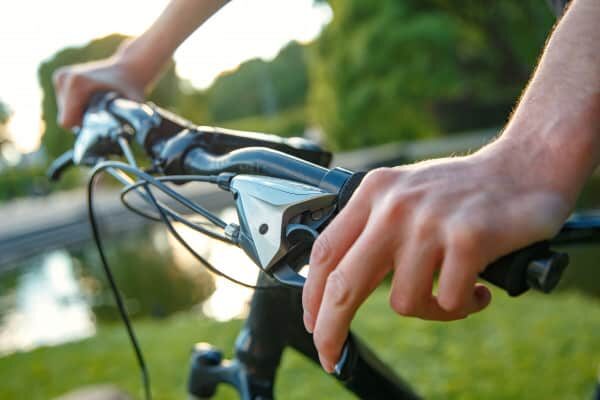
Electric Bike Range Extenders and Carrying a Spare Battery
You can buy a range extender to attach to your electric bike. This is a power bank that charges your battery when your electric assistance is not in use. So for example, this could be when you’re freewheeling or stopped for a break. These can violate your warranty though. Also they may not be compatible with your particular electric bike.
You can even just take a spare battery with you on rides. Like the charger, you can carry this with you in a pannier or backpack. When the battery you’re using runs out, you simply stop and replace it with the spare one. Ideally, make sure both batteries are fully charged before you set off, for maximum range.
My article “How to Choose the Right Electric Bike Battery” talks further about range extenders and having a spare battery.
Conclusion
As you can see from this article, it’s certainly possible to charge your electric bike on the go. So with a little planning and initiative you can go on longer ride
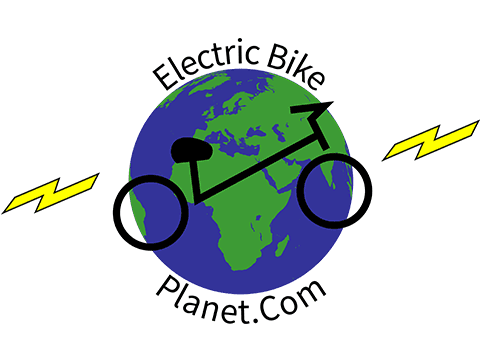
Captain Colyer is an expert in sustainable transportation with a Master’s degree in Environmental Engineering. With over 9 years of experience, he is dedicated to advancing eco-friendly commuting solutions. His work focuses on the latest advancements in electric bike technology and promoting sustainable living practices. At ElectricBikePlanet.com, Captain Colyer shares his in-depth knowledge and practical insights to help readers make informed decisions about electric bikes. Join them on their electric journey for the best e-bike advice and recommendations, and connect on Facebook, Pinterest, and Instagram.


